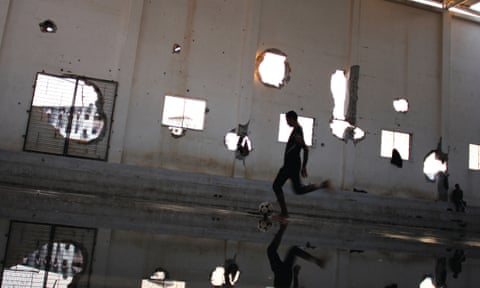Working as a journalist in Gaza, says Palestinian photographer Jehad al-Saftawi, is like walking barefoot in a field of thorns. “You must always watch where you step. Each neighbourhood is composed of its own intimate social network, and travelling through them with a camera makes you a significant suspicion.
“You’re caught between the two sides of the conflict: the rulers of Gaza limit what you can photograph and write about, imprisoning and torturing those who disobey. At the same time, the Israeli army sees you as a potential threat that must be eliminated, as has been the fate of many Palestinian journalists.”

The beach is the only place where Gaza’s nearly two million residents can feel a sense of space
Now living in the US, Saftawi’s book My Gaza is a very personal account of an upbringing in a difficult and violent environment, with abuse from inside his own family as well as life in a conflict zone.
“I’ve put my memories and dreams into these pages. I’ve shared the view from my window.





Everyday scenes in Gaza: residents of Shuja’iyya carry what can be salvaged from their evacuated neighbourhood; one of the Rafah tunnels; flooding; waiting in line to fill up propane tanks
“For years, I clung to the idea of fleeing my country for the western world. In 2016, I managed to leave Gaza for New York, and soon after began the process of seeking asylum in California. People wanted to know how they could help my wife and I, aside from offering financial assistance. Then I received the opportunity to publish my photographs. It’s an opportunity so many of the refugees arriving in the US every day aren’t afforded: the chance to share one’s experience.

“My story is in part the story of my father, Imad al-Saftawi, who raised me with violence and fear, and who, after his 18-year imprisonment in Israel, was set free in December of 2018.

An injured person is carried to the al-Shifa hospital. Civilians played a key role in transporting the injured during Operation Protective Edge
“My parents cared for their children and wished us the best, but we were constantly berated. My siblings and I were made to feel guilty about our soft hands. We were threatened and punished if we didn’t go to the mosque for the five daily prayers. We were forced to wake at 5am to go with my father to pray the Fajr (dawn prayer).




Young people have to make the most of their lives: playing on rubble; burning steel wool to celebrate Ramadan; rollerblading; celebrating Mohammed Assaf winning Arab Idol

Palestinian protesters on Gaza’s eastern border with Israel, holding mirrors to force Israeli soldiers to witness themselves shooting and reflect sunlight to confuse their vision
“I’m now seven thousand miles away from him, from Gaza, and I walk as a free man.

A Palestinian shepherd tends to his sheep near the buffer zone in the northern Gaza Strip. He says he has had many near-death encounters with the remote-control machine guns mounted on some of the Israeli watchtowers
“Standing behind the camera, your hands shake as you document the suffering.




Rainbow flags; Alaa Habib, nine, whose school was badly damaged during Israel’s Operation Protective Edge; my 13-year-old sister Leen from our apartment in Gaza City; my wife Lara connecting with the world through her phone

Queuing for permission to leave Gaza – my wife and I had to pay an Egyptian officer to get our names on the list
“These photographs are visual memories that explore the lives behind the headlines. This work is dedicated to all those trapped in the hardships of this life, surviving in the hopes of a better tomorrow.”

Showing her colours
Jehad al-Saftawi is a documentary journalist, photographer and videographer dedicated to social justice and human rights storytelling. His work has been featured by Reuters, BuzzFeed, AJ+, Mic, Al Jazeera America and the Huffington Post. He arrived in the US from Gaza in 2016 and is currently seeking asylum. He is internationally recognised for setting up one of the few livestreams documenting the 2014 Israeli offensive in Gaza
